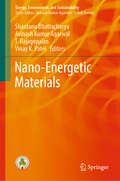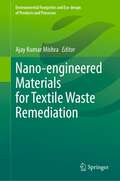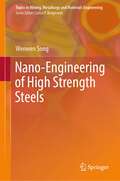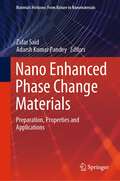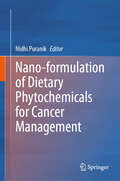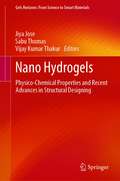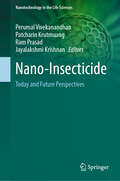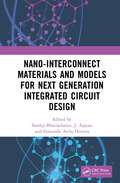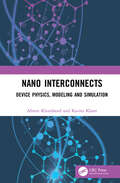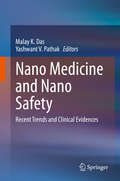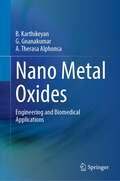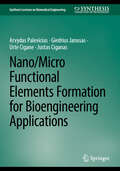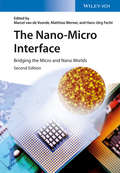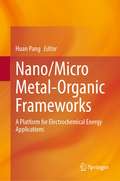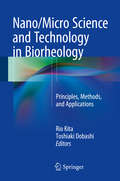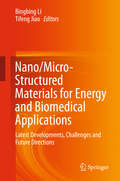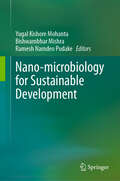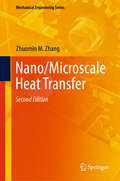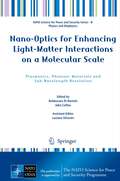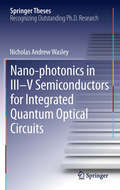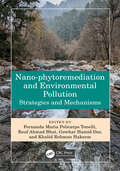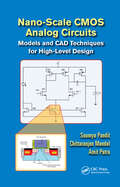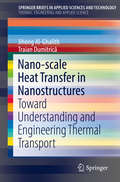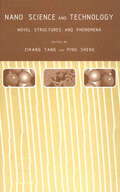- Table View
- List View
Nano-Energetic Materials (Energy, Environment, and Sustainability)
by Shantanu Bhattacharya Avinash Kumar Agarwal T. Rajagopalan Vinay K. PatelThis book presents the latest research on the area of nano-energetic materials, their synthesis, fabrication, patterning, application and integration with various MEMS systems and platforms. Keeping in mind the applications for this field in aerospace and defense sectors, the articles in this volume contain contributions by leading researchers in the field, who discuss the current challenges and future perspectives. This volume will be of use to researchers working on various applications of high-energy research.
Nano-engineered Materials for Textile Waste Remediation (Environmental Footprints and Eco-design of Products and Processes)
by Ajay Kumar MishraThis book presents a complete state of the art for different types of nanomaterial, their environmental fate, and their use in textile waste remediation. Nano-engineered materials including nanoparticles, nanofibers, nanotubes have been used extensively for a variety of applications. Environmental concerns have been noted mainly due to the discharge of textile waste. Nanotechnology is fast growing on research and bringing sustainable solution in minimizing the waste. This also minimizes the risk of exposure and health hazards. With the development of industry, environmental pollution and energy shortage have raised awareness of a potential global crisis. So, it is urgent to develop a simple and effective method to address these current issues. Nano-engineered materials can be better solution in finding solution of environmental sustainability more specific to the textile waste remediation. Nano-engineered materials have emerged as pioneering photocatalysts and account for most of the current research in this area. This can provide large surface areas, diverse morphologies, abundant surface states, and easy device modeling, all of which are properties beneficial to photodegradation. Furthermore, the stability and cost of nano-engineered materials are critical factors. Therefore, it is a challenge of great importance to identify and design nano-engineered materials that are efficient, stable, and abundant for the remediation of textile waste.
Nano-Engineering of High Strength Steels (Topics in Mining, Metallurgy and Materials Engineering)
by Wenwen SongThis book offers new insights into the process of adjusting nanostructures in high-strength steels to achieve enhanced mechanical properties. It summarizes the state-of-the-art nanoengineering approaches, such as precipitation engineering, interface engineering, and short-range ordering engineering. The book explores the nanostructure-process-property relationships in various high-strength steels, including TRIP/TWIP/MBIP in high-Mn steels (HMnS), medium-Mn steels (MMnS), bearing steels, tool steels, and more. The author investigates a novel approach to control the phase transformation process during deformation and/or thermal treatment in steels, employing both experimental and theoretical tools.
Nano Enhanced Phase Change Materials: Preparation, Properties and Applications (Materials Horizons: From Nature to Nanomaterials)
by Zafar Said Adarsh Kumar PandeyThis book provides information on thermal energy storage systems incorporating phase change materials (PCMs) which are widely preferred owing to their immense energy storage capacity. The thermal energy storage (TES) potential of PCMs has been deeply explored for a wide range of applications, including solar/electrothermal energy storage, waste heat storage, and utilization, building energy-saving, and thermal regulations. The inherent shortcomings like leakage during phase transition and poor thermal conductivity hamper their extensive usage. Nevertheless, it has been addressed by their shape stabilization with porous materials and dispersing highly conductive nanoparticles. Nanoparticles suspended in traditional phase change materials enhance the thermal conductivity. The addition of these nanoparticles to the conventional PCM enhances the storage. In this book, the history of Nano Enhanced Phase Change Materials (NEPCM), preparation techniques, properties, theoretical modeling and correlations, and the effect of all these factors on the potential applications such as: solar energy, electronics cooling, heat exchangers, building, battery thermal management, thermal energy storage are discussed in detail. Future challenges and future work scope have been included. The information from this book can enable the readers to come up with novel techniques, resolve existing research limitations, and come up with novel NEPCM, that can be implemented for various applications.
Nano-formulation of Dietary Phytochemicals for Cancer Management
by Nidhi PuranikThis book covers various cancer chemotherapeutics, offering research-oriented overviews of phytochemical-based cancer treatments. It contrasts nano-formulated phytochemical delivery with conventional chemotherapy, introducing nanocarriers or bioengineering for poly-chemotherapy and phytochemicals as alternative treatments to reduce resistance. The text elaborates on the nano-formulation techniques and synthesis approaches of phytochemicals as drugs, the targeted drug delivery facilitated by nanocarriers, and subsequent mechanisms of drug release. Additionally, it examines the implications of nano-formulated phytochemicals in cancer therapeutics and their impact on cancer treatment and prevention. By enhancing bioavailability and improving functional qualities through nanoencapsulation, this innovative approach promises significant advancements in cancer therapy. Key concepts include dietary phytochemicals' role in various types of cancer chemotherapeutics, the pharmacological mechanisms of action in prevention and treatment, and strategies to enhance chemotherapy and radiotherapy efficacy. The book also presents preclinical and clinical studies on the efficacy of phytochemicals in cancer treatment. Additionally, it highlights improvements in drug delivery systems using nanotechnology-based dosage forms for herbal drugs. The content is designed for professionals involved in drug development, including chemists, pharmacists, biologists, biotechnologists, industrialists, nanotechnologists, microbiologists, economists, and all disciplines related to cancer treatment and phytochemical-based drug development. Academic students, scientists, and researchers at universities, institutes, hospitals, botanical institutes, pharmaceutical industries, government organizations, and NGOs will find invaluable insights into the application of phytochemical drugs in cancer treatment. By providing a detailed examination of cutting-edge research on nano-formulated phytochemicals for cancer therapy, this book invites readers to rethink traditional approaches to chemotherapy and explore innovative solutions that promise better outcomes for patients worldwide.
Nano Hydrogels: Physico-Chemical Properties and Recent Advances in Structural Designing (Gels Horizons: From Science to Smart Materials)
by Jiya Jose Sabu Thomas Vijay Kumar ThakurThis book introduces the reader to important aspects of the nano-hydrogels. It covers the development of hydrogels and their biology, chemistry and properties. Focus is also given to innovative characterization techniques and advances in structural design, with special emphasis on molecular structure, dynamic behavior and structural modifications of hydrogels. This book serves as a consolidated reference work for the diverse aspects of hydrogels, creating a valuable resource for students and researchers in academia and industry.
Nano-Insecticide: Today and Future Perspectives (Nanotechnology in the Life Sciences)
by Perumal Vivekanandhan Patcharin Krutmuang Ram Prasad Jayalakshmi KrishnanIn recent years, nanotechnology has emerged as a promising tool for combating insect pests in agriculture, public health, and urban environments. Nanomaterials offer unique properties which can be leveraged to develop targeted and environmentally sustainable pest control solutions. However, despite growing interest in this area, there remains a need for a comprehensive resource that synthesizes the latest research findings and practical applications of nanotechnology for insect pest control. Nano-Insecticide addresses this gap by providing a thorough overview of the diverse applications of nanotechnology in insect pest management. The book covers a wide range of topics, including nanoparticles for insecticide delivery and release, nanostructured materials for pest monitoring and detection, nanobiotechnology approaches for pest-specific targeting, environmental implications, safety considerations and more. Case studies and practical applications from various agricultural and urban settings are also featured. Each chapter is authored by leading experts in their respective fields, ensuring that the book reflects the latest advancements and perspectives in nanotechnology for insect pest control. This book serves as a valuable resource for researchers, practitioners, policymakers, and students interested in the intersection of nanotechnology and pest management. By providing a comprehensive overview of the current state-of-the-art and future directions in the field, Nano-Insecticide aims to stimulate further research and innovation in this critical area. It has the potential to significantly advance our understanding and application of novel pest management strategies.
Nano-Interconnect Materials and Models for Next Generation Integrated Circuit Design
by Sandip Bhattacharya J. Ajayan Fernando Avila HerreraAggressive scaling of device and interconnect dimensions has resulted in many low dimensional issues in the nanometer regime. This book deals with various new generation interconnect materials and interconnect modeling and highlights the significance of novel nano interconnect materials for 3D integrated circuit design. It provides information about advanced nanomaterials like carbon nanotube (CNT) and graphene nanoribbon (GNR) for the realization of interconnects, interconnect models, and crosstalk noise analysis. Features: Focusses on materials and nanomaterials utilization in next generation interconnects based on Carbon nanotubes (CNT) and Graphene nanoribbons (GNR). Helps readers realize interconnects, interconnect models, and crosstalk noise analysis. Describes Hybrid CNT and GNR based interconnects. Presents the details of power supply voltage drop analysis in CNT and GNR interconnects. Overviews pertinent RF performance and stability analysis. This book is aimed at graduate students and researchers in electrical and materials engineering, nano/microelectronics.
Nano Interconnects: Device Physics, Modeling and Simulation
by Afreen Khursheed Kavita KhareThis textbook comprehensively covers on-chip interconnect dimension and application of carbon nanomaterials for modeling VLSI interconnect and buffer circuits. It provides analysis of ultra-low power high speed nano-interconnects based on different facets such as material modeling, circuit modeling and the adoption of repeater insertion strategies and measurement techniques. It covers important topics including on-chip interconnects, interconnect modeling, electrical impedance modeling of on-chip interconnects, modeling of repeater buffer and variability analysis. Pedagogical features including solved problems and unsolved exercises are interspersed throughout the text for better understanding. Aimed at senior undergraduate and graduate students in the field of electrical engineering, electronics and communications engineering for courses on Advanced VLSI Interconnects/Advanced VLSI Design/VLSI Interconnects/VLSI Design Automation and Techniques, this book: Provides comprehensive coverage of fundamental concepts related to nanotube transistors and interconnects. Discusses properties and performance of practical nanotube devices and related applications. Covers physical and electrical phenomena of carbon nanotubes, as well as applications enabled by this nanotechnology. Discusses the structure, properties, and characteristics of graphene-based on-chip interconnect. Examines interconnect power and interconnect delay issues arising due to downscaling of device size.
Nano Lithography (Wiley-iste Ser.)
by Stefan LandisLithography is an extremely complex tool – based on the concept of “imprinting” an original template version onto mass output – originally using relatively simple optical exposure, masking, and etching techniques, and now extended to include exposure to X-rays, high energy UV light, and electron beams – in processes developed to manufacture everyday products including those in the realms of consumer electronics, telecommunications, entertainment, and transportation, to name but a few. In the last few years, researchers and engineers have pushed the envelope of fields including optics, physics, chemistry, mechanics and fluidics, and are now developing the nanoworld with new tools and technologies. Beyond the scientific challenges that are endemic in this miniaturization race, next generation lithography techniques are essential for creating new devices, new functionalities and exploring new application fields. Nanolithography is the branch of nanotechnology concerned with the study and application of fabricating nanometer-scale structures − meaning the creation of patterns with at least one lateral dimension between the size of an individual atom and approximately 100 nm. It is used in the fabrication of leading-edge semiconductor integrated circuits (nanocircuitry) or nanoelectromechanical systems (NEMS).This book addresses physical principles as well as the scientific and technical challenges of nanolithography, covering X-ray and NanoImprint lithography, as well as techniques using scanning probe microscopy and the optical properties of metal nanostructures, patterning with block copolymers, and metrology for lithography. It is written for engineers or researchers new to the field, and will help readers to expand their knowledge of technologies that are constantly evolving.
Nano Medicine and Nano Safety: Recent Trends and Clinical Evidences
by Malay K. Das Yashwant V. PathakThis book reviews the application of Nanobiotechnology in the development of Nanomedicine, while also discussing the latest trends and challenges in the clinical translation of Nanomedicine. Nanomedicine refers to the application of Nanotechnology to medicine and holds tremendous potential for achieving improved efficiency, bioavailability, dose response, personalized medicine and enhanced safety as compared to conventional medicines.The book first introduces readers to the basic concepts of Nanomedicine, and to technological advances in and applications of Nanotechnology in treatment, diagnosis, monitoring, and drug delivery. In turn, it reviews the current status of multi-functionalization strategies for using Nanoparticles in the targeted delivery of therapeutic agents. The book’s third and final section focuses on the regulatory and safety challenges posed by Nanomedicine, including industry and regulatory agencies’ efforts to address them.
Nano Metal Oxides: Engineering and Biomedical Applications
by B. Karthikeyan G. Gnanakumar A. Therasa AlphonsaThis book highlights theoretical and experimental facts about selective nano-metal oxides. TiO2 ,ZnO and transition metal oxides which are known to be semiconductors and find applications in various fields. This book presents about recent findings like photo catalysis, sensing ,coating and biomedical applications. Therapeutic and future applications that are recently been reported of various metal oxides are presented in this book.
Nano/Micro Functional Elements Formation for Bioengineering Applications (Synthesis Lectures on Biomedical Engineering)
by Arvydas Palevicius Giedrius Janusas Urte Cigane Justas CiganasIn recent years, various technologies dedicated to the formation of micro- and nanostructures have been intensively developed. Microstructures and nanostructures are manufactured from various materials with different parameters in a wide range of industrial sectors. These structures are used in devices such as biosensors, optical devices, microfluidic devices, electronic components, fluid mixing devices, particle separation or mixing devices, and single-molecule analysis devices. In this book technologies are being developed for the formation of nano/micro structures that allow the creation of new types of functional elements used in bioengineering. A magnetostrictive converter was developed and studied for the formation of microstructures in polymers, and a newly developed technology using mechanical vibrations during the chemical process was used to form aluminum nanopores. The synergy of these two technologies ensures the creation of a new type of functional elements used in bioengineering. It is presented how to replace the piezoelectric transducer with a magnetostrictive transducer in order to improve hot embossing technology for formation microstructures in polymers. The improved transducer would not only allow for the formation of structures at higher temperatures but would also eliminate the need for an additional heating element which generates a significant amount of heat during the process, thus optimising the device. The important aspects of this system include determining the working parameters of the structure formation which affect the quality and reproducibility of the structures. Research related to nanostructured nanoporous membranes has been receiving a lot of attention from scientists and businesspeople, which is why it is important to develop technologies and deepen knowledge about the chemical and physical processes that take place during fabrication to solve the challenges related to nanostructured membranes. Having it in mind this book presents a novel fabrication technology of nanoporous AAO membranes using vibrations, including production processes, their parameters, and a description of the properties of the fabricated membranes. Moreover, the book presents a technology for replicating the geometry of the AAO membrane in a biocompatible chitosan membrane, when nanopillars are formed on the surface of the chitosan membrane. It also presents the relationships and interactions studied between various parameters, which is achieved by presenting sets of experimental results. Combining these technologies the manufacturing of functional elements and their application to bioengineering. The book will be useful for researchers not only in Mechanical Engineering but also for Material Science and Chemical Engineering. It could be used for master and Ph.D. students too.
The Nano-Micro Interface
by Matthias Werner Marcel Van de Voorde Hans-J?rg FechtControlling the properties of materials by modifying their composition and by manipulating the arrangement of atoms and molecules is a dream that can be achieved by nanotechnology. As one of the fastest developing and innovative -- as well as well-funded -- fields in science, nanotechnology has already significantly changed the research landscape in chemistry, materials science, and physics, with numerous applications in consumer products, such as sunscreens and water-repellent clothes. It is also thanks to this multidisciplinary field that flat panel displays, highly efficient solar cells, and new biological imaging techniques have become reality.This second, enlarged edition has been fully updated to address the rapid progress made within this field in recent years. Internationally recognized experts provide comprehensive, first-hand information, resulting in an overview of the entire nano-micro world. In so doing, they cover aspects of funding and commercialization, the manufacture and future applications of nanomaterials, the fundamentals of nanostructures leading to macroscale objects as well as the ongoing miniaturization toward the nanoscale domain. Along the way, the authors explain the effects occurring at the nanoscale and the nanotechnological characterization techniques. An additional topic on the role of nanotechnology in energy and mobility covers the challenge of developing materials and devices, such as electrodes and membrane materials for fuel cells and catalysts for sustainable transportation. Also new to this edition are the latest figures for funding, investments, and commercialization prospects, as well as recent research programs and organizations.
Nano/Micro Metal-Organic Frameworks: A Platform for Electrochemical Energy Applications
by Huan PangThis book systematically describes the design and synthesis of MOF-related materials and the electrochemical energy storage-related research in the field of batteries. It starts with an introduction to the synthesis of MOF-based materials and various MOF derivatives, such as MOF-derived porous carbon and MOF-derived metal nanoparticles. This is followed by highlighting the interesting examples for electrochemical applications, illustrating recent advances in battery, supercapacitor, and water splitting. This book is interesting and useful to a wide readership in the various fields of chemical science, materials science, and engineering.
Nano/Micro Science and Technology in Biorheology
by Rio Kita Toshiaki DobashiIntegrating basic to applied science and technology in medicine, pharmaceutics, molecular biology, biomedical engineering, biophysics and irreversible thermodynamics, this book covers cutting-edge research of the structure and function of biomaterials at a molecular level. In addition, it examines for the first time studies performed at the nano- and micro scale. With innovative technologies and methodologies aiming to clarify the molecular mechanism and macroscopic relationship, Nano/Micro Science and Technology in Biorheology thoroughly covers the basic principles of these studies, with helpful step-by-step explanations of methodologies and insight into medical applications. Written by pioneering researchers, the book is a valuable resource for academics and industry scientists, as well as graduate students, working or studying in bio-related fields.
Nano/Micro-Structured Materials for Energy and Biomedical Applications
by Bingbing Li Tifeng JiaoThis book discusses the latest developments of the synthesis, preparation, characterization, and applications of nano/microstructure-based materials in biomedical and energetic fields. It introduces several popular approaches to fabricating these materials, including template-assisted fabrication, electrospinning of organic/inorganic hybrid materials, biomineralization-mediated self-assembly, etc. The latest results in material evaluation for targeted applications are also presented. In particular, the book highlights the latest advances and future challenges in polymer nanodielectrics for energy storage applications. As such, it offers a valuable reference guide for scholars interested in the synthesis and evaluation of nano/microstructure-based materials, as well as their biomedical and energetic applications. It also provides essential insights for graduate students and scientists pursuing research in the broad fields of composite materials, polymers, organic/inorganic hybrid materials, nano-assembly, etc.
Nano-microbiology for Sustainable Development
by Yugal Kishore Mohanta Bishwambhar Mishra Ramesh Namdeo PudakeMicrobial diversity and microbial technology are critical to achieving most of the UN Sustainable Development Goals (SDGs), mainly due to their central role in the provision and regulation of ecosystem services. Despite this intensification of effort, more than 90% of microbial diversity remains to be discovered. Thus, the most unique characteristic of microbial technology is the exceptional diversity of applications it can address and the range of human activities and needs to which it is and can be applied. Separately, nanotechnology and microbiology have produced innovative solutions for human well-being and ecological and environmental equilibrium. The development of interdisciplinary research practices combining nanotechnology and microbiology to deliver creative solutions for human health and environmental and ecological damage is urgently required. The nanotechnology of microorganisms is contributing to the development and innovation of numerous industries. This book will explain the fundamentals and methods of the biological production of nanoparticles from microorganisms, such as bacteria, fungi, and algae. It will describe optimization strategies for microbe-mediated nanoparticle production. The book will also discuss the industrial and agricultural applications of nanoparticles produced by microbes. It also describes the applications of green nanoparticles in the health and pharmaceutical sectors, such as the treatment of multidrug-resistant infections and cancer. Overall, the book focuses on the broad subject areas of microbial nanotechnology and its possible applications in food, pharmaceuticals, water, environmental remediation, etc. However, the lack of information and the potential for negative effects on the environment, human health, safety, and sustainability remain obstacles. This book addresses these issues. Researchers and students in the agricultural sciences, materials sciences, biotechnology, microbiology, and pharmaceutical sectors will find this an invaluable resource.
Nano/Microscale Heat Transfer (Mechanical Engineering Series)
by Zhuomin M. ZhangThis substantially updated and augmented second edition adds over 200 pages of text covering and an array of newer developments in nanoscale thermal transport. In Nano/Microscale Heat Transfer, 2nd edition, Dr. Zhang expands his classroom-proven text to incorporate thermal conductivity spectroscopy, time-domain and frequency-domain thermoreflectance techniques, quantum size effect on specific heat, coherent phonon, minimum thermal conductivity, interface thermal conductance, thermal interface materials, 2D sheet materials and their unique thermal properties, soft materials, first-principles simulation, hyperbolic metamaterials, magnetic polaritons, and new near-field radiation experiments and numerical simulations. Informed by over 12 years use, the author’s research experience, and feedback from teaching faculty, the book has been reorganized in many sections and enriched with more examples and homework problems. Solutions for selected problems are also available to qualified faculty via a password-protected website.• Substantially updates and augments the widely adopted original edition, adding over 200 pages and many new illustrations;• Incorporates student and faculty feedback from a decade of classroom use;• Elucidates concepts explained with many examples and illustrations;• Supports student application of theory with 300 homework problems;• Maximizes reader understanding of micro/nanoscale thermophysical properties and processes and how to apply them to thermal science and engineering;• Features MATLAB codes for working with size and temperature effects on thermal conductivity, specific heat of nanostructures, thin-film optics, RCWA, and near-field radiation.
Nano-Optics for Enhancing Light-Matter Interactions on a Molecular Scale
by Baldassare Di Bartolo John Collins Luciano SilvestriThis volume presents a considerable number of interrelated contributions dealing with the new scientific ability to shape and control matter and electromagnetic fields on a sub-wavelength scale. The topics range from the fundamental ones, such as photonic metamateriials, plasmonics and sub-wavelength resolution to the more applicative, such as detection of single molecules, tomography on a micro-chip, fluorescence spectroscopy of biological systems, coherent control of biomolecules, biosensing of single proteins, terahertz spectroscopy of nanoparticles, rare earth ion-doped nanoparticles, random lasing, and nanocoax array architecture. The various subjects bridge over the disciplines of physics, biology and chemistry, making this volume of interest to people working in these fields. The emphasis is on the principles behind each technique and on examining the full potential of each technique. The contributions that appear in this volume were presented at a NATO Advanced Study Institute that was held in Erice, Italy, 3-18 July, 2011. The pedagogical aspect of the Institute is reflected in the topics presented in this volume.
Nano-photonics in III-V Semiconductors for Integrated Quantum Optical Circuits
by Nicholas Andrew WasleyThis thesis breaks new ground in the physics of photonic circuits for quantum optical applications. The photonic circuits are based either on ridge waveguides or photonic crystals, with embedded quantum dots providing the single qubit, quantum optical emitters. The highlight of the thesis is the first demonstration of a spin-photon interface using an all-waveguide geometry, a vital component of a quantum optical circuit, based on deterministic single photon emission from a single quantum dot. The work makes a further important contribution to the field by demonstrating the effects and limitations that inevitable disorder places on photon propagation in photonic crystal waveguides, a further key component of quantum optical circuits. Overall the thesis offers a number of highly novel contributions to the field; those on chip circuits may prove to be the only means of scaling up the highly promising quantum-dot-based quantum information technology.
Nano-phytoremediation and Environmental Pollution: Strategies and Mechanisms
by Khalid Rehman Hakeem Rouf Ahmad Bhat Gowhar Hamid Dar Fernanda Maria Policarpo TonelliThe book discusses nano-phytoremediation: the use of nanotechnology in combination with phytoremediation to restore polluted environs. The potentiality of plants in association with nanomaterials to effectively remediate polluted areas is elaborated meritoriously in this book. New strategies are necessary because anthropogenic actions represent a serious threat to life on Earth. This book has given enough space for a discussion of innovative and efficient technologies to restore damaged environs primarily focused on nano-phytoremediation. The first part of the book is dedicated to exploring organic and inorganic pollution and the threats they pose to living forms. The second part explores the joint use of plants and nanomaterials and the nano-phytoremediation of water and soil ecosystems. The book offers readers extensive knowledge on nano-phytoremediation as a feasible strategy to clean environmental pollution. The key features of the book are as follows: Nano-phytoremediation strategies to remediate soil and water ecosystems. Special chapters dedicated to different kinds of pollutants and methods of phytoremediation. Strategies to evaluate the success of nano-phytoremediation strategies, cost-effectiveness, and nano informatics to safe nanotechnology. The book can be used as a primary or supplementary text in undergraduate, graduate, and post-graduate courses such as biotechnology, biochemistry, and environmental engineering. It is an interesting edition for instructors, researchers, and scientists working on environmental management and pollution control.
Nano-scale CMOS Analog Circuits: Models and CAD Techniques for High-Level Design
by Soumya Pandit Chittaranjan Mandal Amit PatraReliability concerns and the limitations of process technology can sometimes restrict the innovation process involved in designing nano-scale analog circuits. The success of nano-scale analog circuit design requires repeat experimentation, correct analysis of the device physics, process technology, and adequate use of the knowledge database. Starting with the basics, Nano-Scale CMOS Analog Circuits: Models and CAD Techniques for High-Level Design introduces the essential fundamental concepts for designing analog circuits with optimal performances. This book explains the links between the physics and technology of scaled MOS transistors and the design and simulation of nano-scale analog circuits. It also explores the development of structured computer-aided design (CAD) techniques for architecture-level and circuit-level design of analog circuits. The book outlines the general trends of technology scaling with respect to device geometry, process parameters, and supply voltage. It describes models and optimization techniques, as well as the compact modeling of scaled MOS transistors for VLSI circuit simulation. • Includes two learning-based methods: the artificial neural network (ANN) and the least-squares support vector machine (LS-SVM) method • Provides case studies demonstrating the practical use of these two methods • Explores circuit sizing and specification translation tasks • Introduces the particle swarm optimization technique and provides examples of sizing analog circuits • Discusses the advanced effects of scaled MOS transistors like narrow width effects, and vertical and lateral channel engineering Nano-Scale CMOS Analog Circuits: Models and CAD Techniques for High-Level Design describes the models and CAD techniques, explores the physics of MOS transistors, and considers the design challenges involving statistical variations of process technology parameters and reliability constraints related to circuit design.
Nano-scale Heat Transfer in Nanostructures: Toward Understanding And Engineering Thermal Transport (SpringerBriefs in Applied Sciences and Technology)
by Jihong Al-Ghalith Traian DumitricăThe book introduces modern atomistic techniques for predicting heat transfer in nanostructures, and discusses the applications of these techniques on three modern topics. The study of heat transport in screw-dislocated nanowires with low thermal conductivity in their bulk form represents the knowledge base needed for engineering thermal transport in advanced thermoelectric and electronic materials, and suggests a new route to lower thermal conductivity that could promote thermoelectricity. The study of high-temperature coating composite materials facilitates the understanding of the role played by composition and structural characterization, which is difficult to approach via experiments. And the understanding of the impact of deformations, such as bending and collapsing on thermal transport along carbon nanotubes, is important as carbon nanotubes, due to their exceptional thermal and mechanical properties, are excellent material candidates in a variety of applications, including thermal interface materials, thermal switches and composite materials.
Nano Science and Technology: Novel Structures and Phenomena
by Zikang Tang Ping ShengNanoscience and technology is a rapidly developing area of research in physics, chemistry, and materials. This volume comsists of papers presented at the Advanced Study Institute in Hong Kong that explore developments in novel structures in phenomena of nanostructured materials. The topics include:two-dimensional nanoclusters on met
